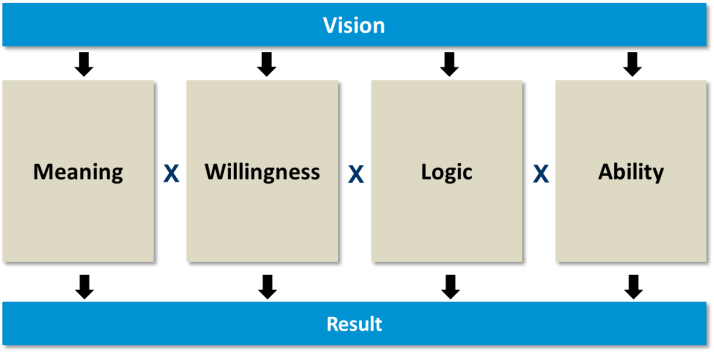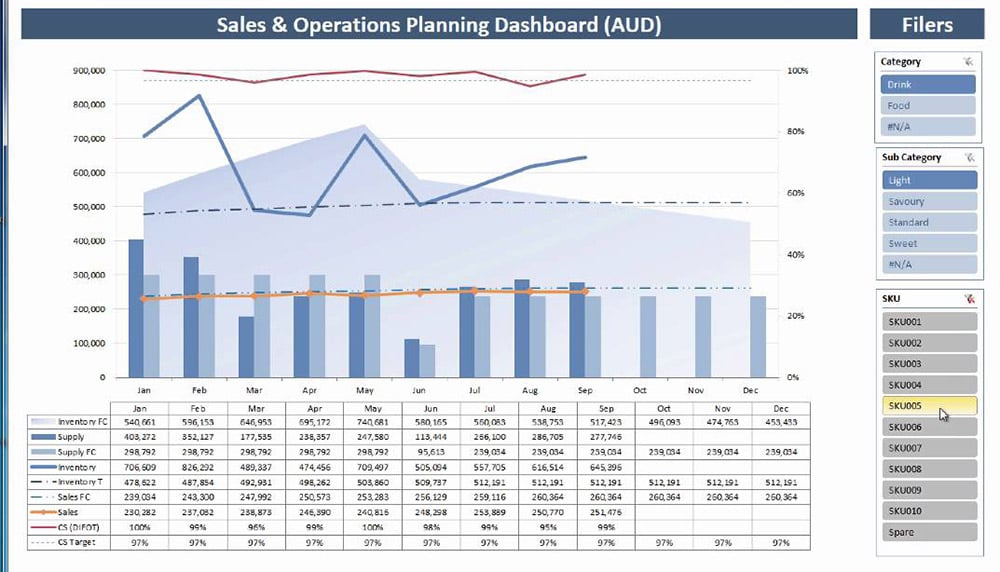Tactical, integrated planning for competitive advantage
Sales and Operations Planning (S&OP) gives businesses a tactical edge: deepening market insights, balancing supply and demand and adapting finances accordingly.
Shaping a planning process and actionable strategy in parallel, S&OP positions your people — from supply chain to sales — to stop firefighting and cultivate a proactive mindset. Delivering cross-functional synchronisation and the headspace to focus on continuous improvement, it primes a new era of dynamism for your organisation.
Explore S&OP: from business benefits and gaining employee buy-in to managing roll-out and software selection.
What is S&OP?
Sales and Operations Planning (S&OP) is a process that enables businesses to access and develop a key competitive advantage. Through tactical planning, you’ll combine customer-centric marketing and sales plans with supply chain insights.
S&OP simultaneously generates a planning process and a medium-term outcome plan. The process is designed to formulate, roll out, monitor and continuously enhance the plan. The overall aim? To increase your sales, ensure you can reliably deliver on your customers’ expectations and decrease your expenses.
S&OP processes have 3 primary goals:
- Determining demand — mapping which products, and how many of them, customers are going to purchase from you
- Ensuring supply — assessing your capability to meet customer demand, including ensuring supply chain resilience
- Aligning financial goals — (re)defining your financial planning based on the actual supply-demand balance

Effective S&OP is a team effort
Kept separate, your sales, marketing, development, manufacturing, sourcing and financial planning will never bring your company maximum benefit. Combined, however, they become a sum greater than their parts. S&OP blends them into united, powerful integrated planning.
To keep your S&OP on the pulse, regular planning meetings and reviews are crucial. To effectively and adaptively map your company’s short-term to medium-term future, these meetings will at a minimum:
- Consider any supply, demand and new product planning
- Cover both detailed and aggregate data
- Link back to and support your company’s wider business plan
- Review performance measurements to ensure continuous improvement
Several types of meetings are needed to reach consensus among your departments and formulate progressive and responsive planning. These bring together inputs from across your company (marketing, sales, production, finance and management) to generate planning with cross-functional buy-in.
What are the business benefits of S&OP?
S&OP is regarded as a priority business process — and for good reason. Implemented well, its potential to positively impact all levels of your company is huge. S&OP supports enhancing strategy, control and decision-making across your entire enterprise; reducing firefighting and enabling your best minds to focus on forward-thinking, tactical work.
✓ Align business planning and tactics
✓ Cultivate proactive, not reactive, mindsets
✓ Create a clear, well-formed short-term to medium-term plan
✓ Unify a cross-departmental plan and process
✓ Align customer value with supply chain efficiency
✓ Engage in dynamic, continuous improvement
S&OP, S&OE, IBP: What’s the difference?
Sales and Operations Planning (S&OP)
As we’ve outlined, S&OP is a tactical process focused on the mid-term. Rolling plans cover 12 to 18 months, creating a medium-term plan by combining short-term certainties with longer-term assumptions.
Sales and Operations Execution (S&OE)
By contrast, S&OE focuses specifically on the short-term (2 to 3 months). This covers detailed execution planning based on immediate certainties. Punctual demand, current promotions, sales funnels, open orders, and so on, down to product-level detail.
S&OE exists to specifically cover short-term planning — meaning S&OP meetings can be set aside for medium-term thinking. To succeed, your S&OE and S&OP processes should be complementary yet connected.
Integrated Business Planning (IBP)
S&OE/S&OP allow businesses to navigate changing, uncertain circumstances. Yet organisations need the next maturity level to ensure they become truly integrated and resilient: Integrated Business Planning (IBP).
IBP is the natural evolution of S&OE/S&OP frameworks; the next step in S&OP maturity.
It incorporates:
- Business intelligence
- Business strategy
- Financial decision-making
- Gap-closing
- Market share
- Service levels
- Ecosystem partnerships
In overall planning and process maturity, S&OE evolves to S&OP which evolves to IBP. Already at the IBP stage? Explore our overview here, or download our leader’s guide to value chain resilience.
S&OP: A journey from strategy to schedule
S&OE, S&OP and IBP are all decision-making processes aiming to proactively balance demand and supply.
But how does an S&OP process work in practice? For larger businesses especially, it can be tricky to maintain a big-picture overview. Likewise, to monitor and understand the interlinked flows that underpin effective supply and demand planning.
Needless to say, each organisation’s S&OP/IBP needs are unique — according to the company, market, structure and business needs. Beyond that, effective S&OP is constantly updating and evolving, adapting to changes in business and market dynamics.
In collaboration with Supply Chain Movement, we created a Subway Map to help visualise a standard S&OP process. It depicts a fictional organisation with S&OP maturity level 3, working in a Make-to-Stock scenario with a rapidly evolving product portfolio. The next step for this business? Evolving their S&OP maturity to integrate IBP.
Why is S&OP crucial for sales success?
S&OP enables your business to fulfill its potential as a reliable supplier, no matter the product you sell or the market you sell in. And if you can guarantee delivery reliability, that makes your sales team’s life far easier!
Contracts and promotions quickly turn sour if they’re not coordinated in time with your supply chain. Then customers aren’t content and sales won’t meet their targets. With effective S&OP in place, however, the offers sales makes are aligned with the actual capabilities of your supply chain.
By making decisions based on the consensus demand-supply plan, your company can live up to its promises, ensure on-time delivery, avoid lost sales and enhance customer loyalty. Avoiding bottlenecks and proactively reaching out to the right markets based on a co-defined approach, sales and supply chain will unite to accelerate your business growth.
1. Avoid surprises
Let’s explore this scenario: Inventories are piling up. Operations is working overtime — yet still struggling to produce the right quantities. Sales is struggling to create better forecasts, unable to perform at their best without improved insights. Meanwhile, customers are disappointed and complaining that you’re not delivering on their expectations.
If this is at all familiar, S&OP can support you to gain back control of your primary processes and create strong, productive relationships between your supply chain, operations and sales. Enhancing your delivery reliability for customers, making employees’ lives better and improving overall business performance.
2. Design controllable processes
If your primary processes are feeling out of control, S&OP can help. But there might be a fix that needs to occur before you can design and implement your S&OP process.
The first question is: Are the processes you have in place controllable? In other words, will trying to manage and improve them with S&OP work? Or are the processes themselves in need of a fundamental redesign first — so that they can actually be controlled?
Reviewing your company’s concept of control first, before implementing S&OP, ensures you’re making the right call at the right time.
Be smart before you start: A successful S&OP approach in 5 steps
S&OP is a vital tool for balancing supply and demand — but it needs to be implemented thoughtfully. To avoid it failing to live up to your expectations, we recommend following these steps to successfully roll out (or revive) your S&OP:
1. Define your ‘why’ to set clear targets
What are your stakeholders aiming to achieve with S&OP? Are their expectations and goals aligned? Clear targets are vital to introducing effective S&OP. Without them, it’s easy to lose your way.
However, diving straight in and focusing on the hard content of your S&OP — KPIs, process, data, systems — misses a crucial step. First, you need buy-in from all the teams who will be involved to ensure it will be a success. Why should they invest time and energy in contributing to and rolling out S&OP? In making it a priority in their daily work? In adapting to the change and persevering through its early stages? From the supply chain side to the commercial side, everyone needs to see what’s in S&OP for them and how it will help them to perform at their best at work.
2. Assess your as-is S&OP scenario
Are there existing S&OP processes in your company that need reshaping? Or will you be introducing S&OP from scratch? First, find out from which positions, and with which doubts or expectations, your various stakeholders are approaching S&OP.
An S&OP Maturity Scan can be useful here. Based on defined questions, it can help rate and benchmark your business across 4 key categories:
1) S&OP Process
2) Supply & Demand Planning
3) Performance Management
4) Ownership
Bear in mind that effective S&OP brings multiple, diverse parties to the table. Sales, purchasing, operations, finance and general management will pool insights and strategies, meaning different objectives, (hidden) agendas, ways of working and ways of thinking need to be reconciled. Clear communication, coordination and transparency are key to success.
3. Make a blueprint
With your clear targets set, it’s time to translate them from an aim to an action plan. Your blueprint will reflect the nature of your business, from product and customer to geographical and structural specificities.
Your blueprint defines an actionable vision of your S&OP process structure, including:
- Meeting schedule and setup
- Tasks and responsibilities for each stakeholder (group)
- The aggregation level of relevant data
- IT support needed
Your blueprint should be devised, spearheaded and adapted as needed by a leading coalition, designated from within your company’s experts to head up your S&OP implementation.
In scoping out your blueprint, be disciplined in keeping your short-term S&OE process (2 to 3 months) and your mid-term S&OP process (12 to 18 months) linked but independent. This doesn’t just ensure functional, efficient decision-making for both S&OE and S&OP, without scope creep. It also ensures you can have the right people involved in each set of meetings, making the most of individuals’ time and expertise. Those with on-the-ground insights need to define S&OE, whereas S&OP requires management-level input.
4. Implement in gradual stages
Following on from your blueprint, ensure to pursue your S&OP plans step by step. Going too fast will likely cause overload, leading to disappointing results.
Start with basic, foundational changes across your departments, to ensure everyone is keeping pace with the evolution. Evaluating the monthly S&OP meetings is crucial here, to monitor changes made and to set plans in motion to continue your S&OP process development.
Ultimately, through an intelligent and gradual introduction, the aim is for S&OP to become an intuitive mindset throughout your company.
5. Ensure you have the right people involved
S&OP is a complex structure — with game-changing results when done well. Making sure you have the right skills and competencies at the table is key. If not, take action. Switch people into and out of roles; upskill as needed through training; bear in mind that perhaps not everyone is up to the task.
1. Sole focus on ‘hard’ content
Concrete facts and data are crucial to S&OP. However, they’re not enough alone. Hard logic, process, data and systems need to be complemented with ‘softer’ aspects. This ensures the cross-functional buy-in that, as we’ve seen, is crucial for S&OP success.
To ensure this balanced focus for our clients, our S&OP Change Model incorporates 4 pillars: Meaning, Willingness, Logic and Ability.


2. Dashboard? What dashboard?
To track your S&OP performance, a sophisticated dashboard is crucial. It will need to consider KPIs both within the scope of your S&OP process and in external processes that impact it. Revenues, margins and supply chain performance, for example.
Your S&OP dashboard should be smart, consistent and reliable, combining cross-functional data to track progress. Your dashboard will be a source of truth for assessing whether your process is effective or whether you need to evolve your S&OP to ensure it lives up to its promises.
It should support and encourage outside-in and inside-out thinking, ensuring you have the right data at hand to continuously improve your S&OP process. At Involvation, this is our speciality. Entirely independent from the leading software suppliers we work with, we’re able to shape dashboards for our clients that are fully tailored to their S&OP needs.
3. All talk, no decisions
You have S&OP meetings. Everyone is informed and on the same page. Somehow, though, no decision is made. So the process stagnates.
For success, concrete decisions must be taken in each S&OP meeting, generating results and evolutions before the next meeting takes place. Heading into each meeting with well-prepared options for each designated decision topic is vital. This enables all participants to efficiently make optimal, data-driven decisions. Cultivating this approach ensures a high-quality S&OP process in your company. Likewise, it paves the way for an effective IBP process when your S&OP maturity reaches that stage.
S&OP: Change management is the key to success
S&OP success requires a comprehensive change management approach. As we see it at Involvation, it’s like playing chess on multiple boards.
By this, we mean that your change management strategy for S&OP needs to cover multiple key pillars at once. These are the components in our S&OP Change Model: Meaning, Willingness, Logic and Ability
Meaning — Ensure all stakeholders understand what’s in S&OP for them
Have your S&OP objectives well-defined, as well as communicated to and understood by all relevant parties. This supports generating enthusiasm, motivation and perseverance company-wide. To kick-start this, senior management needs a clear vision of S&OP success in the company. This then needs to be translated into resonant motivations for the specific roles of the individuals involved, to ensure buy-in.
Willingness — Ensure commitment and willingness to act
Who are your core stakeholders, S&OP ambassadors and S&OP sceptics? Take time to discover and define what drives the ambassadors and what’s holding the sceptics back. You’ll need to respectively support and alleviate these beliefs to ensure success. Individual misconceptions, concerns and even over-enthusiasms need to be managed. Likewise, formal organisational structures or IT systems creating barriers to your S&OP implementation need to be removed. With time and effective management, change will come.
Ability — Ensure the team involved has the right skills and competencies
Ultimately, the people involved will determine the success of your S&OP process. Cross-functional, tactical thinking is a key competence that everyone at the table needs. If it’s not already a natural strong point in your candidates, it can be effectively developed with training. At Involvation, we’re highly experienced in training to enhance S&OP capability.
Capability-building for S&OP
There’s power in serious gaming
When it comes to getting a practical message across, presentations will only get you so far. By enabling your people to interactively experience the importance, process and pay-off of S&OP, you can enhance employees’ commitment to its implementation and cultivate the skills they need to see it through.
Serious gaming in virtual environments is a helpful tool here. S&OP (and, later, IBP) are best learned by going through the process and receiving structural feedback. In the real world, however, a full cycle lasts months — too slow for effective learning. S&OP simulation games provide a great alternative that’s most effective in combination with formal learning, coaching and PDCA cycles.
Software and S&OP: Selecting the right system
Over the past decade, software capabilities for S&OP have evolved rapidly. Data aggregation, scenario simulation and sophisticated forecasting and analysis are now readily available in state-of-the-art systems.
But with so many capabilities and options, it’s tough to know which tech to select — so we support clients to include the right tech in their S&OP (and IBP) processes, setting them up for data-driven success.
What’s also evolving is the forward-looking nature of demand planning. Previously based solely on historical sales data, forecasting now extends to diverse external and projected data sets and exploits AI and specifically Machine Learning More accurate and more powerful, we’re proud to support clients in harnessing these opportunities.
At Involvation, we’re also particularly invested in supporting our clients to integrate ML, AI and cloud-based capabilities into their S&OE, S&OP and IBP. Above all, helping clients cut through the buzzword noise and identify technologies that can genuinely add value to their specific business scenario.
Checklist: Assess your as-is S&OP
Before running a full assessment, you can use our checklist — developed with Supply Chain Media — to carry out an initial review of your current S&OP process.
- Is it truly safeguarding well-structured decision-making in your company?
- Is it creating a comprehensive view of supply and demand?
- Are you accurately assessing medium-term financial impact?
- What added value is your S&OP delivering?
- What is its future potential?
S&OP Assessment: What are the benefits?
✓ Independent evaluation of your current S&OP process (maturity and effectiveness)
✓ Objective opinion on the buy-in and relevant competencies of the team executing your S&OP
✓ Overview of potential improvements (short-term and longer-term)
✓ Step-by-step plan for improvement implementation
S&OP Assessment: Our process in brief
Our 3-step approach takes place over 5 - 6 weeks:
1. Intake
A meeting to discuss the assessment scope, setup and planning.
2. Interviews, document analysis, journey through a cycle
Conversations with your key stakeholders, as well as analysing the documents and dashboards in use and following a full S&OP cycle in your company. In-depth analysis allows us to formulate a tailored improvement plan.
3.Feedback and roadmap
We present our findings, discuss our conclusions with you and look ahead to an improvement roadmap.
Harness the power of S&OP
We’re here to help you leverage S&OP to transform your supply chain and business performance. With a step-by-step, tailored approach, we support you to enhance your market understanding, take back control of planning and elevate both your margins and your customer experience.




